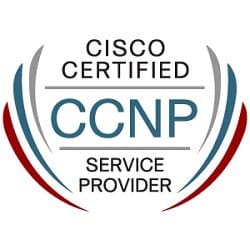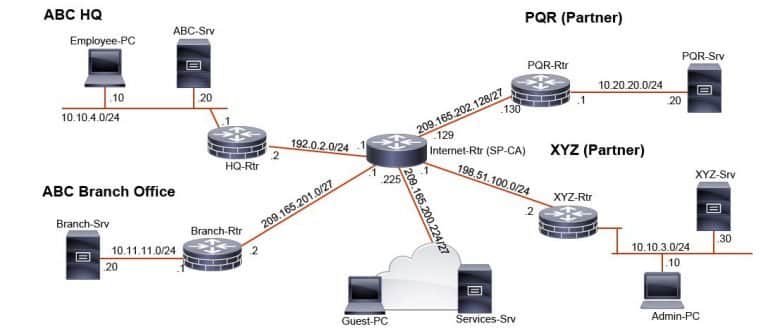Obiettivi | Certificazione | Contenuti | Tipologia | Prerequisiti | Durata e Frequenza | Docenti | Modalità di Iscrizione | Calendario

Il Corso SPVI Implementing Cisco Service Provider VPN Services è parte del percorso Cisco CCNP Service Provider. Questo corso si focalizza sull’implementazione MPLS per soluzioni VPN in ambito Service Provider. Saranno affrontati argomenti come: Layer 3 Overlay VPN, Peer-to-Peer MPLS VPNs, VRF Instances, MP-BGP Routing, PE-to-CE Routing, Multicast VPN, Layer 2 VPNs, Ethernet VPNs, EVPN VPWS, IPv6 over MPLS VPN, 6VPE e altro ancora. Il Corso contribuisce alla preparazione dell’esame di Certificazione CCNP Service Provider (Esame 300-515).
Contattaci ora per ricevere tutti i dettagli e per richiedere, senza alcun impegno, di parlare direttamente con uno dei nostri Docenti (Clicca qui)
oppure chiamaci subito al nostro Numero Verde (800-177596)
Obiettivi del corso
Di seguito una sintesi degli obiettivi principali del Corso SPVI Implementing Cisco Service Provider VPN Services:
- Implementazione MPLS per soluzioni VPN in ambito Service Provider.
- Comprensione di Layer 3 Overlay VPN e Peer-to-Peer MPLS VPNs.
- Studio delle VRF Instances e MP-BGP Routing.
- Approfondimento su PE-to-CE Routing e Multicast VPN.
- Analisi di Layer 2 VPNs, Ethernet VPNs e EVPN VPWS.
Certificazione del corso
Esame 300-515 SPVI Implementing Cisco Service Provider VPN Services;
Esame parte della Certificazione CCNP Service Provider. Il programma di certificazione CCNP Service Provider prepara per i ruoli professionali nelle odierne tecnologie sulla fornitura di servizi telematici enterprise. La CCNP Service Provider ora include elementi di automazione e programmabilità per la massima scalabilità delle moderne infrastrutture dei service provider. In particolare l’esame 300-515 SPVI testa competenze su argomenti quali: implementing service provider VPN services, VPN Layer 2, VPN Layer 3, VPN IPv6.
Contenuti del corso
- Introducing VPN Services
- VPN Fundamentals
- Traditional Layer (IP) Overlay VPN Types
- Peer-to-Peer MPLS VPNs
- MPLS VPN Control Plane Operation
- VRF and Routing in the MPLS VPN Control Plane
- Verify the Service Provider Backbone Operation for MPLS VPN
- Layer MPLS VPN Data Plane Operation
- Work with VRF Instances
- Troubleshooting MPLS VPN Underlay
- Troubleshoot Core IGP
- Troubleshoot LSP and LDP
- Troubleshoot BGP
- Troubleshoot Route Summarization Issues
- Troubleshoot the MPLS VPN Backbone
- Implementing Layer MPLS VPNs
- MP-BGP Routing Requirements in MPLS VPNs
- Configure MP-BGP as the PE-CE Routing Protocol
- PE-to-CE Routing Requirements in Layer MPLS VPNs
- Configure and Verify PE-to-CE Routing Requirements
- Implement Extranet and Shared Services in Layer MPLS VPNs
- Enable Shared Services VPN
- Deploy Internet Access as a VPN Service
- No Medal
- Implementing Layer Interdomain MPLS VPNs
- Inter-AS for Layer MPLS VPNs
- CSC for Layer MPLS VPNs
- Implementing Layer Multicast MPLS VPNs
- Multicast VPN Fundamentals
- Implement Intranet MVPN
- Implement Extranet MVPN
- Implement Multicast LDP for Layer Multicast MPLS VPN
- Implement Multicast VPN with mLDP
- Troubleshooting Intra-AS Layer VPNs
- Troubleshoot PE-CE Connectivity
- Troubleshoot PE-PE Connectivity
- Troubleshoot PE-to-Route Reflector
- Troubleshoot Layer MPLS VPN End-Customer Connectivity
- Implementing Layer VPNs
- Layer Service Architecture and Carrier Ethernet Services
- Refresh on Traditional E-LAN, E-Line, and E-Tree Solutions
- EVPN Model for Ethernet Services Delivery
- Implement Ethernet VPNs (EVPN)
- Implement Ethernet Operations, Administration, and Maintenance
- Implement Different EVPN Solutions
- Troubleshooting Layer VPNs
- Troubleshoot Common Issues for Traditional E-Line, E-LAN, and E-Tree Ethernet Solutions
- Troubleshoot Common Issues for EVPN Native, EVPN VPWS, and EVPN IRB Solutions
- Troubleshoot EVPN VPWS
- Implementing Layer IPv MPLS VPNs
- Classical Solutions to Deploy IPv over IPv Environments
- Basic Solutions to Deploy IPv over MPLS VPN Environments
- Use PE to Deploy IPv Connectivity over MPLS Environment
- Use VPE to Deploy IPv Connectivity over MPLS Environment
- Use GRE for IPv Connectivity in MPLS VPN Environments
- Routing Requirements for IPv Connectivity over MPLS VPNs
- Implement VPE
- Troubleshooting Layer IPv MPLS VPNs
- Troubleshoot PE-to-PE Connectivity
- Troubleshoot PE-to-CE Connectivity
Attività Laboratoriali
- Verify the Service Provider Backbone Operation for MPLS VPN
- Work with VRF Instances
- Troubleshoot the MPLS VPN Backbone
- Configure MP-BGP as the PE-CE Routing Protocol
- Configure and Verify PE-to-CE Routing Requirements
- Enable Shared Services VPN
- Deploy Internet Access as a VPN Service
- Troubleshoot Layer 3 MPLS VPN End-Customer Connectivity
- Implement Different EVPN Solutions
- Troubleshoot EVPN VPWS
- Implement IPv6 VPN Provider Edge Router (6VPE)
Tipologia
Corso di Formazione con Docente
Docenti
I docenti sono Istruttori accreditati CISCO e certificati in altre tecnologie IT, con anni di esperienza pratica nel settore e nella Formazione.
Infrastruttura laboratoriale
Per tutte le tipologie di erogazione, il Corsista può accedere alle attrezzature e ai sistemi reali Cisco presenti nei Nostri laboratori o direttamente presso i data center Cisco in modalità remota h24. Ogni partecipante dispone di un accesso per implementare le varie configurazioni avendo così un riscontro pratico e immediato della teoria affrontata. Ecco di seguito alcune topologie di rete dei Laboratori Cisco Disponibili:

Dettagli del corso
Prerequisiti
Si consiglia la partecipazione al Corso Cisco CCNA.
Durata del corso
- Durata Intensiva 5gg;
Frequenza
Varie tipologie di Frequenza Estensiva ed Intensiva.
Date del corso
- Corso Cisco SPVI (Formula Intensiva) – Su richiesta – 9:00 – 17:00
Modalità di iscrizione
Le iscrizioni sono a numero chiuso per garantire ai tutti i partecipanti un servizio eccellente.
L’iscrizione avviene richiedendo di essere contattati dal seguente Link, o contattando la sede al numero verde 800-177596 o inviando una richiesta all’email contatti@vegatraining.eu.


